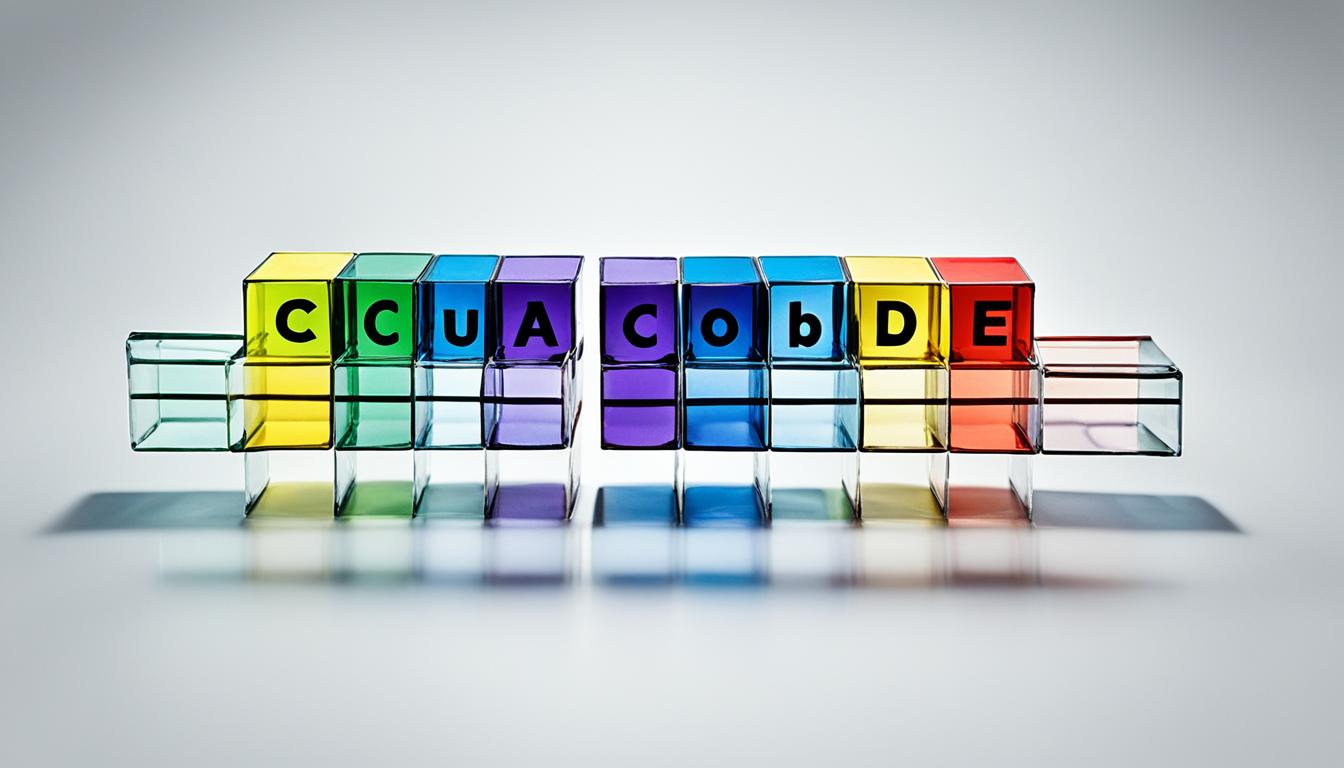Did you realize that a basic mental exercise can offer valuable insights into your personality? The Cube Test Personality is an intriguing tool that enables you to reveal various facets of your inner self and enhance self-awareness. By visualizing a white room and responding to questions about the objects inside it, you can gain a peek into your characteristics and preferences.
Key Takeaways:
- The Cube Test Personality is a quick mental exercise that can provide insights into your personality.
- By imagining a white room and answering questions about the objects within it, you can gain self-awareness.
- The Cube Test Personality can be a fun way to understand different aspects of your inner self.
- While not a scientific test, it offers a unique perspective on personality traits.
- Use the Cube Test Personality as a tool for self-reflection and discussion, but rely on professional assessments for a comprehensive understanding of your personality.
How the Cube Test Works
The Cube Test is a fascinating mental exercise that allows us to gain insights into our personality traits and preferences. This simple yet powerful test requires you to imagine a white room and answer questions about the objects within it. Let’s explore how this test works and what it can reveal about ourselves.
The Cube: Your Ego and Self-Perception
In the Cube Test, the cube itself represents your ego or how you see yourself. As you imagine the cube in the room, its size, color, and placement can provide valuable insights into your self-perception. A larger cube may indicate a strong sense of self-importance, while a smaller cube may suggest humility and a more modest self-image. The color of the cube can also convey different aspects of your personality.
Other Objects: Symbols of Different Life Aspects
Along with the cube, the room contains various other objects like flowers, ladders, horses, and storms. Each of these objects represents different aspects of your life and can provide clues about your preferences and priorities.
Remember, these objects are symbolic, and their interpretation is subjective. The true meaning lies in the unique associations you make during the test.
Flowers: Relationships and Social Preferences
Flowers in the room represent your relationships and social preferences. The number of flowers may indicate your desire for a larger social circle or a preference for close and intimate connections. The location and color of the flowers can offer insights into your emotional closeness to others and your general attitude towards relationships.
Ladder: Goals and Ambitions
The ladder symbolizes your goals and ambitions in life. Its placement and size within the room can reveal the significance of your aspirations. If the ladder leans against the cube, it suggests that your goals align with your self-perception. Additionally, the material and color of the ladder can provide further insights into your aspirations and feelings towards achieving them.
Horse: Partnerships and Ideal Partner
The horse in the cube test represents your current or ideal partner. Its position within the room and its characteristics offer glimpses into your relationships and what you value in a partner. A horse close to the cube may indicate a strong connection, while a tied horse may suggest a desire for control in a relationship. The overall impression of the horse can reflect your expectations and feelings towards romantic partnerships.
Rainstorm: Challenges and Obstacles
The rainstorm in the room represents the obstacles and challenges you face in life. The proximity and intensity of the rainstorm can indicate the difficulties you encounter. A larger, more intense storm may suggest a chaotic or overwhelming life, while a smaller storm may indicate fewer obstacles. The relationship between the rainstorm and other objects in the room can reveal the source or cause of these difficulties.
By interpreting our answers and analyzing the associations we make with the objects in the room, we can gain valuable insights into our personality traits, preferences, and inner world. While the Cube Test is not a definitive assessment, it provides a unique opportunity for self-reflection and self-awareness.
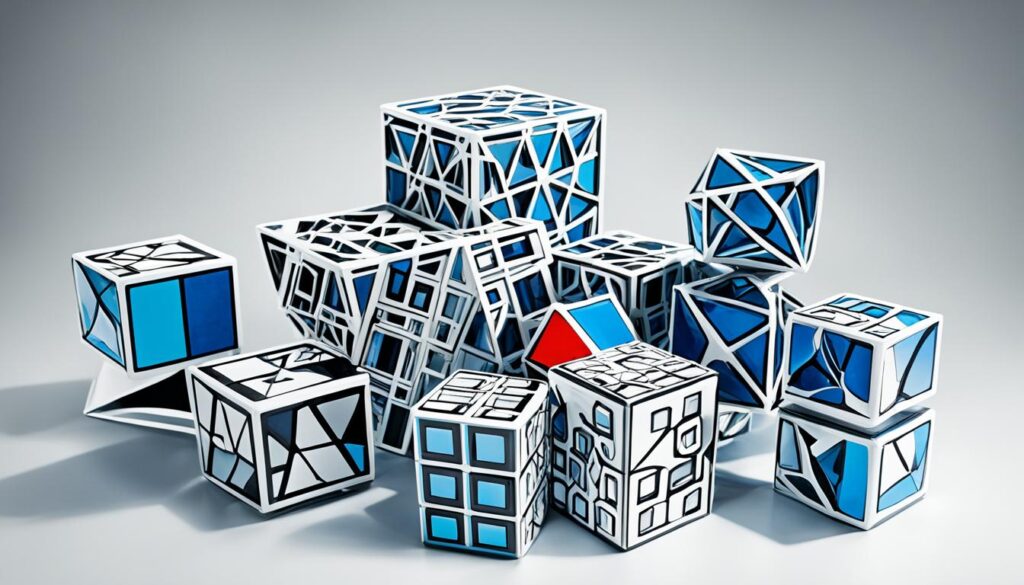
Continue reading as we delve deeper into the interpretation of specific objects and their significance within the Cube Test. Unlock the hidden layers of your personality and discover fascinating insights about yourself.
Interpreting the Cube in the Room
In the Cube Test Personality, the cube represents your ego or how you perceive yourself. But what can the size and color of the cube tell us about your self-perception? Let’s dive deeper into the interpretation of the cube in the room.
The size of the cube can reveal important insights into your personality. A small cube may indicate a humble nature, suggesting that you don’t consider yourself to be the center of attention. On the other hand, a large cube suggests a higher level of self-importance, indicating that you have a strong sense of self-worth and confidence in your abilities.
Now, let’s explore the color of the cube. Different colors hold symbolic meanings that can shed light on your self-perception. For example:
A red cube signifies passion, determination, and ambition. You may have a bold and assertive personality, driven by your desire to achieve your goals.
A blue cube represents calmness, harmony, and empathy. You may possess a peaceful and empathetic nature, valuing emotional connection and understanding.
A yellow cube symbolizes optimism, creativity, and intellectual curiosity. You may have a bright and imaginative personality, always seeking new ideas and solutions.
A green cube signifies balance, growth, and harmony with nature. You may have a nurturing and compassionate personality, valuing harmony and environmental sustainability.
Next, let’s move on to the location of the cube in the room. Is it on the ground or floating in the air? The placement of the cube can provide insights into your stability and predictability in life.
If the cube is on the ground, it suggests that you have a grounded and stable nature. You prefer a sense of security and routine in your life, and you may prioritize practicality and logical thinking in decision-making.
On the other hand, if the cube is floating in the air, it signifies a more unpredictable and adventurous side to your personality. You may embrace change, take risks, and seek out new experiences. You may value freedom and spontaneity in your life, often going with the flow rather than sticking to a specific plan.
Remember, the interpretation of the cube in the room, its size, color, and location, is just one piece of the puzzle when it comes to understanding your personality. Let’s move on to explore the role of other objects in the room, such as the flowers, ladder, horse, and rainstorm, to gain a more comprehensive understanding of who you are.
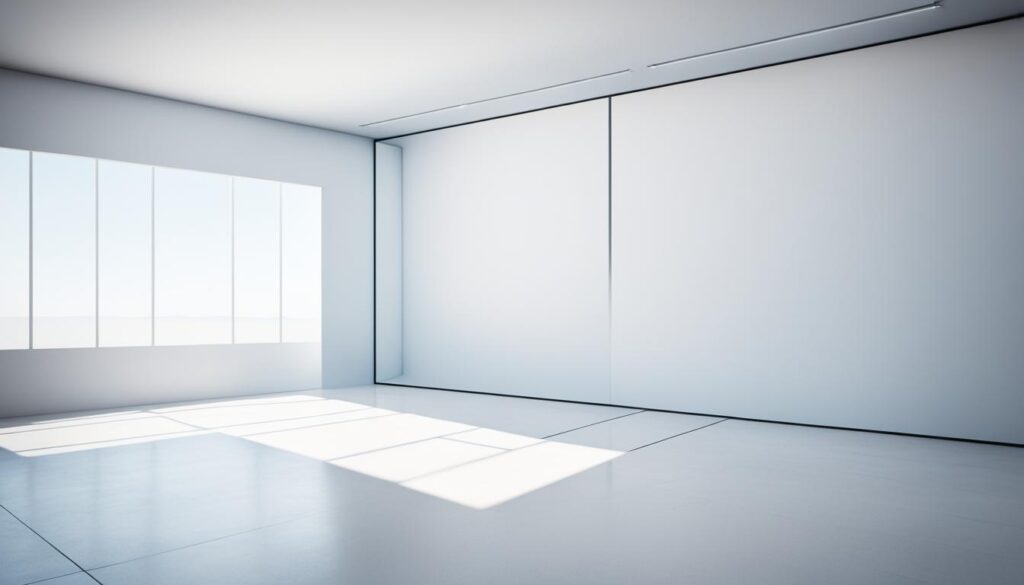
Understanding the Flowers in the Cube Test
The presence and characteristics of flowers in the room can provide valuable insights into your relationships and social preferences. Whether you imagine a single flower or a blooming garden, each choice holds significance.
Number of Flowers: The number of flowers you envision can signify your desire for social connections. A larger number of flowers may indicate a preference for a larger social circle and a more extroverted nature. On the other hand, a smaller number of flowers suggests a preference for close-knit relationships and a greater focus on quality over quantity.
Location and Color of Flowers: Pay attention to where you place the flowers in the room and their colors. The location of the flowers can reveal your emotional closeness to others. For example, if you imagine the flowers near the cube, it may indicate a deep emotional connection and a strong desire for intimacy in your relationships. Alternatively, if the flowers are placed farther away, it may suggest a need for personal space and independence.
The color of the flowers also holds meaning. Different flower colors are associated with various emotions and sentiments. For instance, red flowers may symbolize passion and love, while white flowers may represent purity and innocence. Consider the feelings evoked by the colors you choose in relation to your attitudes and experiences with relationships.
“The flowers you choose and the way you envision them in the room can provide valuable insights into your social preferences and emotional closeness to others.”
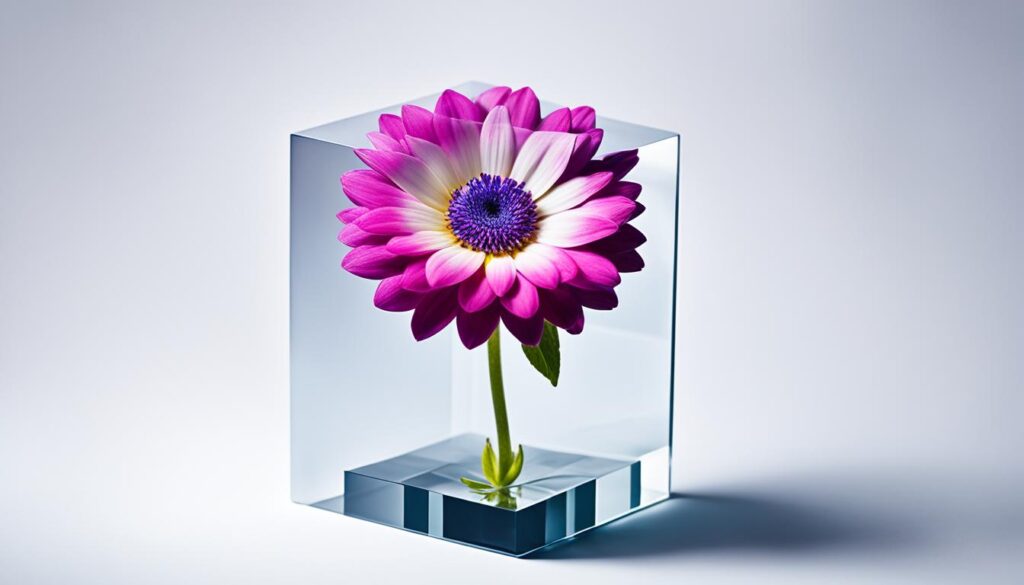
Flower Interpretation Summary:
When interpreting the flowers in the Cube Test, consider the number, location, and color. More flowers may indicate a desire for a larger social circle, while fewer flowers suggest a preference for close-knit relationships. The location of the flowers reflects emotional closeness, with proximity to the cube representing deep intimacy. Additionally, the choice of flower colors expresses different emotions and sentiments associated with your relationships.
Decoding the Ladder in the Cube Test
The ladder in the room holds significant meaning, representing your goals and ambitions. Its interpretation relies on several factors, including its placement, size, material, and color. Let’s dive into the different aspects of the ladder and what they can reveal about your aspirations and feelings towards achieving them.
Firstly, the placement of the ladder within the imaginary room is crucial. If the ladder is leaning against the cube, it suggests a strong alignment between your goals and your self-perception. This indicates that your ambitions resonate with your personal identity, and you have a clear understanding of the path you want to pursue toward success.
The size of the ladder speaks to the significance you assign to your goals. A larger ladder denotes a high level of importance and priority you give to your ambitions. It signals that you are willing to invest substantial effort and resources into achieving your objectives. On the other hand, a smaller ladder indicates a more modest approach and potentially a preference for more manageable and attainable goals.
The material and color of the ladder can add additional insights into your aspirations. For example, a wooden ladder may suggest a desire for stability and grounding in your pursuits. A metal ladder, on the other hand, could reflect a more structured and disciplined approach to your goals.
| Interpretation | Symbolism |
|---|---|
| Leaning against the cube | Alignment between goals and self-perception |
| Large ladder | High importance and priority assigned to goals |
| Small ladder | Modest approach with manageable goals |
| Wooden ladder | Desire for stability and grounding |
| Metal ladder | Structured and disciplined approach |
By analyzing these different elements of the ladder, we can gain a deeper understanding of your aspirations and motivations. Remember, the Cube Test provides a fun way to explore various aspects of your personality, allowing for self-reflection and introspection along the way.

Continue your journey through the Cube Test by decoding the horse in Section 6. Let’s uncover insights into your relationships and what you value in a partner.
Analyzing the Horse in the Cube Test
The horse in the Cube Test represents your partner or ideal partner. Its position in the room and characteristics provide insights into your relationships and what you value in a partner. Let’s delve into the interpretation of the horse in more detail.
Positioning of the Horse
The position of the horse in the room can reveal the level of connection you seek in a romantic relationship. If the horse is positioned close to the cube, it may suggest a strong bond and emotional closeness with your partner. On the other hand, if the horse is farther away, it could indicate a preference for independence and personal space within a relationship.
“The closer the horse is to the cube, the stronger the bond.”
Additionally, the placement of the horse relative to other objects can provide further insights. For example, if the horse is near the ladder, it may suggest a desire for shared ambitions and goals in your relationship. Conversely, if the horse is far from the ladder, it could indicate a focus on individual aspirations.
Characteristics of the Horse
The characteristics of the horse in the Cube Test can also reveal important aspects of your ideal partner. For instance, the presence of a tied horse may indicate a desire for control or structure in a relationship. It could suggest a preference for clear boundaries and a need for stability.
“A tied horse may symbolize a desire for control or stability within a relationship.”
Conversely, if the horse appears untied or free, it may suggest a more relaxed and easygoing approach to relationships, valuing freedom and spontaneity.
Overall Impression and Symbolism
The overall impression of the horse in the Cube Test is crucial in understanding your feelings and expectations towards romantic relationships. Take note of the emotions evoked by the horse’s presence, such as feelings of warmth, comfort, or excitement. This can provide valuable insights into the qualities you value in a partner and the type of relationship dynamics you seek.
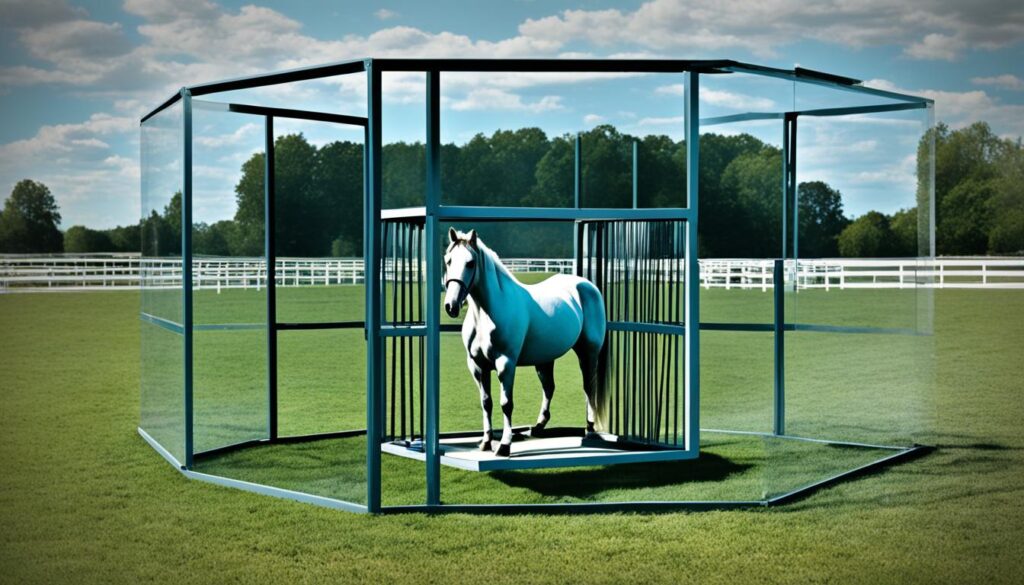
| Horse Position | Interpretation |
|---|---|
| Close to the cube | Strong emotional connection |
| Far from the cube | Preference for independence |
| Near the ladder | Shared ambitions and goals |
| Far from the ladder | Focus on individual aspirations |
Exploring the Rainstorm in the Cube Test
In the Cube Test, the rainstorm symbolizes the obstacles and challenges that we encounter in our lives. The interpretation of the rainstorm depends on its proximity and intensity, reflecting the difficulties we may be facing.
A rainstorm that is large and intense signifies a chaotic and overwhelming life. It suggests that you may be dealing with significant challenges and obstacles that require your attention and resilience.
On the other hand, a smaller rainstorm suggests a lesser impact of challenges. This indicates that you may be experiencing relatively milder obstacles and difficulties in your life.
It is crucial to analyze the rainstorm in the context of other objects present in the room to understand the source or cause of the difficulties. By examining the relationship between the rainstorm and other elements, we can gain deeper insights into the challenges we face.
To further illustrate the interpretation of the rainstorm in the Cube Test, consider the following examples:
My rainstorm was large and intense, accompanied by thunder and lightning, indicating the turbulent period I was going through with numerous personal and professional challenges.
Her rainstorm was small and gentle, resembling a peaceful summer shower. This suggested that she was experiencing minor obstacles in her life, with less impact on her overall well-being.
By examining the proximity, intensity, and association of the rainstorm with other objects in the Cube Test, we can gain valuable insights into the challenges we face and how they affect our lives.

Understanding the Rainstorm in the Context of Other Objects
The rainstorm can further be analyzed by considering its interaction with other objects in the room. The combination of elements provides a comprehensive understanding of the challenges and obstacles we encounter.
For example, if the rainstorm is located near the cube, it suggests that the difficulties are closely related to our self-perception. This may indicate that our personal struggles or insecurities contribute to the challenges we face.
Additionally, the rainstorm’s interaction with other objects, such as the flowers, ladder, and horse, can offer insights into specific areas of our lives that are affected by the challenges. By examining these relationships, we can gain a holistic understanding of how obstacles impact our emotions, relationships, and aspirations.
| Symbol | Interpretation |
|---|---|
| Rainstorm | Obstacles and challenges in life |
| Cube | Self-perception and ego |
| Flowers | Relationships and social preferences |
| Ladder | Goals and ambitions |
| Horse | Partnerships and ideal partner |
By examining the rainstorm in conjunction with other objects, we can gain a comprehensive understanding of how challenges impact different areas of our lives and the complexity of their interactions.
The Cube Test as a Fun Exercise
While the Cube Test is not a scientifically validated personality test, it can be an entertaining way to learn more about yourself and others. It can be used as a party trick or icebreaker activity. However, it should be taken with a grain of salt and not used as a substitute for professional psychological assessments. The Cube Test offers a fun and light-hearted perspective on personality traits and can provide an opportunity for self-reflection and discussion.
| Pros | Cons |
|---|---|
| Engaging and entertaining | Not scientifically validated |
| Can spark interesting conversations | Does not provide comprehensive insights |
| Can be used as a party trick or icebreaker | Subjective interpretation of answers |
It’s important to note the limitations of the Cube Test. While it can be a fun exercise, it is not a substitute for professional psychological assessments. The test relies on subjective interpretation and does not provide comprehensive insights into your personality. Use it as a starting point for self-reflection and understanding, but don’t solely rely on its results.
The Cube Test at a Glance
- Fun activity to gain self-awareness.
- Not scientifically validated.
- Can be used as a party trick or icebreaker.
- Subjective interpretation of answers.
- Offers a light-hearted perspective on personality.
“The Cube Test is a great way to break the ice at parties and get to know people on a deeper level. It’s amazing to see the different interpretations and discussions that arise from this simple exercise.” – Sarah Adams, Psychology Enthusiast
While the Cube Test may not provide definitive insights into your personality, it can still offer a fun and engaging experience. Use it to spark conversations and explore different perspectives. Remember, self-awareness is an ongoing journey, and the Cube Test can serve as a stepping stone towards understanding yourself and others.

Conclusion
The Cube Test Personality offers a unique and thought-provoking way to gain self-awareness and understand different aspects of our personalities. By imagining a white room and answering questions about the objects within it, we embark on a journey of uncovering our inner selves.
While the Cube Test is not a definitive assessment, it can serve as a valuable tool for self-reflection and creating connections with others. It allows us to explore our thoughts, emotions, and preferences in a fun and engaging manner.
However, it is important to remember that the Cube Test should not replace more reliable and in-depth personality assessments. While it offers insights into our personality traits, it cannot comprehensively capture the complexity of our individuality. It is advisable to seek professional guidance and use other validated assessments for a more complete understanding of our personalities.
Embrace the Cube Test as a means of self-exploration, foster self-awareness, and foster discussions with others about our unique traits and perspectives. Enjoy the experience, but remember that it is just one puzzle piece in the larger picture of understanding ourselves and those around us.
How Does the Cube Test Personality Assessment Compare to Enneagram Type Three Traits?
The cube test personality assessment evaluates various aspects of an individual’s personality, while the traits of enneagram type three focus on achievement-oriented behavior, a desire for validation, and a tendency towards being image-conscious. Both provide insights into an individual’s character, but the enneagram type three traits specifically emphasize ambition and a focus on success.
FAQ
What is the Cube Test Personality?
The Cube Test Personality is a quick mental exercise that can provide insights into your personality. It involves imagining a white room and answering questions about the objects in the room.
Is the Cube Test Personality a scientific test?
No, the Cube Test is not a scientifically validated personality test. However, it can be a fun way to gain self-awareness and understand different aspects of your inner self.
How does the Cube Test work?
The Cube Test requires you to imagine a white room and answer questions about the objects within it. The interpretation of your answers can provide insights into your personality traits and preferences.
What does the cube in the room represent in the Cube Test?
The cube in the room represents your ego or how you see yourself. Its size and color can reveal insights into your self-perception.
What do the flowers in the room indicate in the Cube Test?
The flowers in the room provide insights into your relationships and social preferences. The number, location, and color of the flowers can reveal your emotional closeness to others and your overall feelings towards relationships.
What does the ladder in the room symbolize in the Cube Test?
The ladder in the room represents your goals and ambitions. Its placement and size can indicate the importance of your goals in your life, while the material and color of the ladder can provide insights into your aspirations and feelings towards achieving them.
What does the horse in the room signify in the Cube Test?
The horse in the room represents your partner or ideal partner. Its position and characteristics can reveal aspects of your relationships and what you value in a partner.
What does the rainstorm in the room represent in the Cube Test?
The rainstorm in the room symbolizes the obstacles and challenges in your life. The proximity and intensity of the rainstorm can reflect the difficulties you may be facing.
Is the Cube Test a reliable assessment of personality?
While the Cube Test can offer insights into personality traits, it should be taken with a grain of salt and not used as a substitute for professional psychological assessments.
Can the Cube Test be used as a fun activity?
Yes, the Cube Test can be used as a party trick or icebreaker activity. It offers a fun and light-hearted perspective on personality traits and can provide an opportunity for self-reflection and discussion.
Felicity, our Author, pens in-depth articles and guides that delve into the heart of personal discovery. Her narrative-driven approach weaves together theory, practice, and personal anecdotes, making the journey of self-exploration both relatable and inspiring. Felicity’s contributions help illuminate the path for those seeking a deeper understanding of themselves and their relationships.
